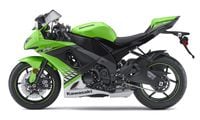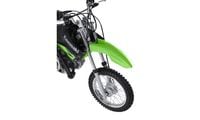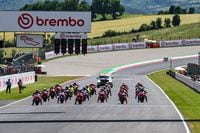Kawasaki has over the last few years made a very strong performance push in its lineup, and 2010 is no different. We got a first look at a few of the more significantly changed new models.
Biggest news for Kawasaki in 2010 is the return of the Z1000. Not just a rehash of the bike last sold in the States in 2008, this Z1000 hits the road with an all-new aluminum frame (it was previously steel) and larger 1043cc inline-Four replacing the old model's 953cc mill. Steering is described as "quick" and a new rear suspension design with a horizontally mounted single shock (featuring adjustments for rebound damping and spring preload) is said to improve handling. The 41mm inverted fork is fully adjustable. An interesting touch is the adjustable-tilt instrument panel. Petal-disc brakes with radial master cylinder and radial-mount calipers show clear sporting intentions. Liter-class naked bikes are about the most practical fun on the market, and the Z1000 is priced at a competitive $10,499 in Pearl Stardust White or Metallic Spark Black. Kawasaki makes a big point about the "feeling" provided by the new engine and chassis, as all bike-makers appear to be trying to inject more distinct personality into their products.
The Concours 14—a two-time Cycle World Ten Best winner in the Sport-Touring category—received numerous changes to improve comfort and safety. After a now-you-see-it, now-you-don't traction-control episode on the ZX-10R in 2008, the Concours 14 gets the honor of being the first production Kawasaki with a factory-installed traction-control system, dubbed KTRC. On the braking side, the dual-mode K-ACT II "coactive" ABS system offers sport-oriented tuning and is designed to "complement the rider's brake inputs with supplementary force enhancements for improved braking performance on a wide variety of riding surfaces." One braking mode is optimized for sport riding with more distinct front-to-rear braking control left to the rider. The other mode—called High Combined—adds more combined braking force on application of the rear pedal, intention being better stopping while riding two-up or during more mellow touring. The most welcome tweaks to this fine, high-speed sporty bike are improved heat management to keep the rider cooler and a 2.8-inch-taller windscreen (still electrically adjustable) for smoother airflow and better weather protection. Sharper bodywork styling, heated grips, retuned suspension and new Bridgestone BT021 tires (for lighter handling) are bonuses. The non-ABS version's MSRP is $14,599, while the ABS model goes for $15,299. The one available color combination is Candy Neptune Blue/Flat Super Black.
The Ninja ZX-10R proved to be wickedly fast in our "0-180 mph" cover story (CW, July, 2008) and the 2010 version hasn't lost a bit of the muscle it showed versus the 1000cc-and-up sportbikes in that comparison test. Styling updates sharpen the Kawasaki flagship superbike, the fairing is redone inside and out, and the muffler is more compact. Mechanical changes this year are minor, with the big news being a redone six-speed transmission incorporating design lessons learned from the slick-shifting Ninja ZX-6R. An upgraded twin-tube Öhlins adjustable steering damper completes the $12,999 package in Metallic Spark Black. A special-edition Lime Green/Pearl Stardust White paint scheme goes for $13,199.
The 2010 Kawasaki Versys returns with a few enhancements. One of the great all-around middleweights on the market gets fresh styling, rubber engine mounts and revised footpegs to reduce vibration from the 650cc parallel-Twin felt by the rider. The adjustable windscreen has been changed to be more effective and fit the new styling, while passenger accommodations are altered and bungee hooks have been added under the seat. The long-travel suspension and 5.0-gallon fuel capacity remain on this $7599 machine.For the kids (mostly!), the 2010 KLX110 and KLX110L mini-motocrossers get a more powerful sohc 111cc Single with electric starting and a four-speed transmission. Rear suspension has better bottoming resistance, and ergonomics have been opened up to accommodate a wider range of riders. The standard KLX110 ($2099) is more beginner-ready with its lower 26.8-inch seat height and centrifugal clutch. The KLX110L ($2249), meanwhile, runs a manual clutch and 1.9-inch-taller seat, in addition to having longer-travel suspension.











































/cloudfront-us-east-1.images.arcpublishing.com/octane/A4EN3OE2HRBXVFICJ6K62CNXCM.jpg)
/cloudfront-us-east-1.images.arcpublishing.com/octane/ZBLIY3XNQ5ACNNJ65IL44KBZAE.jpg)
/cloudfront-us-east-1.images.arcpublishing.com/octane/HDO56KGQB5H25DJRM2J2PH2E5A.jpg)
/cloudfront-us-east-1.images.arcpublishing.com/octane/NZKPFUWBHVGYJAFQPCXWAK6BZM.jpg)
/cloudfront-us-east-1.images.arcpublishing.com/octane/K5ZSQFMYQZHWRFXTTW4PEWMUDM.jpg)
/cloudfront-us-east-1.images.arcpublishing.com/octane/D2SOSBIQQRBPTERNSOJRAW3KYY.jpg)
/cloudfront-us-east-1.images.arcpublishing.com/octane/DS3Q5X2VJFFAJDK2PWB3Y7K6U4.jpg)
/cloudfront-us-east-1.images.arcpublishing.com/octane/4KBL4JAMYRFDPEINTWATDUH7OM.jpg)
/cloudfront-us-east-1.images.arcpublishing.com/octane/FXADK3MVSNBRTKJ2B7TPDCCJ5Y.jpg)
/cloudfront-us-east-1.images.arcpublishing.com/octane/M7L2CPXO55FRFMECW7QGDPGP6E.jpg)
/cloudfront-us-east-1.images.arcpublishing.com/octane/T4RWGLAEHVE2VCJZOTFTNGB2KA.jpg)
/cloudfront-us-east-1.images.arcpublishing.com/octane/JM4QGLAHWNGHPM74OEB7FVBFSY.jpg)
/cloudfront-us-east-1.images.arcpublishing.com/octane/BGPNXPDDYBHD3HL6YEZQOYHXTI.jpg)
/cloudfront-us-east-1.images.arcpublishing.com/octane/SND5GGQV4RDPPMZBSBEGIZ4SIY.jpg)
/cloudfront-us-east-1.images.arcpublishing.com/octane/XUDDAPYZMZEL5EDPVDJ2DTULWI.jpg)
/cloudfront-us-east-1.images.arcpublishing.com/octane/M7AU2L6GAVCJVHW57LIRPDAAUQ.jpg)

/cloudfront-us-east-1.images.arcpublishing.com/octane/JKEJY7P43JGD5C5NJO2VJQJPUM.jpg)
/cloudfront-us-east-1.images.arcpublishing.com/octane/YROKYJYUQVGPHCEMPTGBWDQCKQ.jpg)
/cloudfront-us-east-1.images.arcpublishing.com/octane/QIHEYR66TZDAPCGMWHCWCBC4XA.jpg)
/cloudfront-us-east-1.images.arcpublishing.com/octane/4FTBMNZL5BD2ZHY62XXRHJW6PI.jpg)
/cloudfront-us-east-1.images.arcpublishing.com/octane/L2BHKRCEMFDF7O3S4REZXPDH2E.jpg)
/cloudfront-us-east-1.images.arcpublishing.com/octane/QHENIV3HMJCTTCXQ6O5YPTNRZ4.jpg)
/cloudfront-us-east-1.images.arcpublishing.com/octane/K3VNQBIAKVGIHIGBRG7QKJYLVI.jpg)